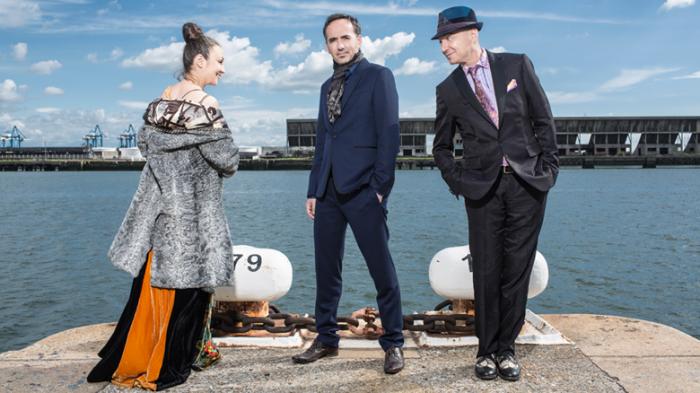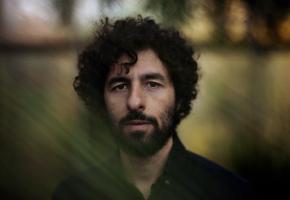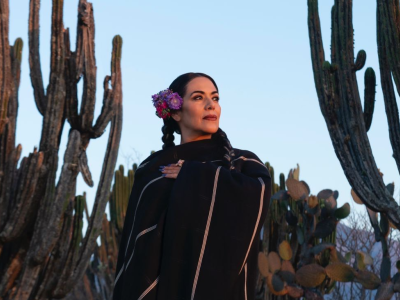Before, Tango was often coupled with tradition, Argentina or sweet fizzy drinks. Then came the Gotan Project, propelling their synth-heavy fusion of the traditional Argentine genre and electronica onto the music scene in the 1990s. Tango became something else; the soundtrack to films and cafes and anything that wanted to be cool.
Inspired by the sounds of New Order and the Talking Heads and, of course, the melancholy mood of traditinal Tango, Gotan Project’s gold and two platinum selling albums in France from 2001 to 2010 are testament to the fact that old and new, classical, folk and electronic can combine to create something special.
Now the original founders Christoph and Eduardo are once again breaking the mould with Plaza Francia. Joined by the stirring vocals of Catherine Ringer and combining their superfluity of musical styles and deep love of tango, their album A New Tango Songbook is fast approaching gold status in France, although it was released only last week in the UK.
Ringer has enjoyed an equally illustrious career, having performed in the hugely acclaimed Les Rita Mitsouko for almost thirty years before becoming a solo artist. She has appeared in a number of films, some of which are family-friendly and others that aren’t so much! She is bursting with passion, expertise and tricks of the trade. Latino Life interviewed Christoph and Catherine prior to their performance next Thursday at La Linea Festival.
Latino Life: What was the inspiration behind forming Plaza Francia?
Christoph: We wanted to develop tango canción; tango songs, using a female singer. Catherine’s name popped up pretty quickly, she seemed like a perfect match for what we wanted to do, which was to combine traditional tango from Argentina with pop songs of the last 50 years. We wanted to develop tango culture’s old-fashioned soul into something more contemporary.
LL: How did you decide upon the name?
Christoph: Plaza Francia is named after the square in Buenos Aires, which was named in honour of the relation between France and Argentina. Tango has evolved largely due to the interaction between these two countries. Catherine is French; Eduardo’s Argentine and we’re all based in Paris so it made sense to emphasize the link between Paris and Buenos Aires.
LL: What are the origins of tango and what are its major influences?
Christoph: Tango came from Argentina, from the mix of African slaves and European immigrants. It was a hybrid right from the beginning, like jazz. Its major influences are from Italy, Germany, as well as Jewish violins and African musical styles. All of this mixed in the suburbs of Buenos Aires in the early 20th century, and then moved over to Paris where it initially formed part of an underground, clandestine culture. It quickly became much more glamorous, which increased its popularity in Argentina. It has developed a lot in its 100 years of history, thanks to the likes of Astor Piazzola, and now it occupies its own genre… but we are trying to break up this purist notion and push tango towards the future.
LL: Gotan Project was the first band to mix electronic music with tango. What was your inspiration to do so?
Christoph: Tango music was always dance-oriented. So our main inspiration was to try to bring the Tango to the contemporary dance floor, to take it out of classical settings and move it into to the clubs of today.
LL: Your album, A New Tango Songbook was released last week in the UK, congratulations! Tell us a bit about the first song, La Mano Encima. What is it about?
Christoph: The song has dramatic, tango-inspired lyrics but features subjects and themes from today. La Mano Encima is about a woman saying ‘No’ to a man who beats her. It is contrary to what you would find tango songs from older times, where men would sometimes justify or normalise their violent actions towards women. We wanted to counter this machisto element of tango, and bring the lyrics into the 21st century. It marks a change in conditions for women.
LL: Its music video features a brilliantly choreographed routine between two lovers. What are you trying to convey?
Christoph: We wanted to work with a great choreographer called Sidi Larbi Cherkaoui because we thought it would be really interesting to express the story of the song, and its violent themes, through dance. The idea was to tell the whole story of their relationship through one dance scene; they meet and fall in love, he is violent towards her and she ultimately she rejects him, even though she still loves him. We wanted to express this all through dance.
LL: In the past, you’ve combined a whole range of styles, including Nueva Cumbia and Afro-Soul. Can you identify particularly with the combination of Latin America and African styles of music?
Christoph: Definitely. The influence of African music in Latin American music is huge. In tango, the role of African music was traditionally not given any credit. One of the main artists who fought against this was Juan Carlos Cacéres, who died very recently. He made a record called Tango Negro that strongly pushed the recognition of Africa’s involvement in tango, and today it is a lot more officially recognised. Africa’s influence on Latin American music is major – it may not be obvious but it’s everywhere.
LL: You’re performing at La Linea festival in London on the 23rd of April. Is tango becoming more popular in the UK or is it true that we all have two left feet?
Christoph: Nonsense, the British can dance! The major European cities for the tango are Paris and Berlin, in London there’s a pretty big scene too. But tango is popular everywhere in the world. There are even tango events in Kazakhstan every week… It’s crazy! We’ve seen it on tour with Gotan Project; we toured around the world and it was just everywhere, in places you would never imagine. I think it’s becoming more popular every day, especially with young people.
Catherine
LL: How did you get involved with Plaza Francia?
Catherine: Plaza Francia was formed by Eduardo Makaroff and Christoph Müller from the Gotan Project two years ago. They wanted to move away from their electronic style more towards pop, to move tango in a different direction. They didn’t want a specialist Argentine or Spanish tango singer; they wanted a twist of something different. We initially did two songs, which worked really well, and then they asked if I wanted to do a whole album together. I love to experiment with different styles, so I said ‘yes!’ and that’s where the voyage started.
LL. What are your objectives as a band?
Catherine: To conjure up emotions and feelings, even if you don’t understand the lyrics. All of the words are in Spanish, so when we play in France, not many people can understand what I’m singing about! But we try to convey what the words mean through the sound we create.
LL. Have you always been interested in tango?
Catherine: Yes. I love old tango and new tango - a genre that is not that new anymore! The French have been big fans of tango since the 1920s and it has influenced a lot of French music throughout the 20th century. Even lots of contemporary songs are based on its rhythm and harmonies, so it’s very close both to myself, and the French people.
LL. What are the major emotions that recur in your music?
Catherine: New love, Old love, jealousy, sadness, happiness. But also Diaspora; missing a country you have left.
LL. Art features heavily on your album cover and on your stages. Can you tell us a bit about the style?
Catherine: It is inspired by an Argentine art form, called Fileteado, which combines flowers and climbing plants with letters and decorations. You see it everywhere in Buenos Aires, as urban art, on street signs, even on old colectivos. I think it’s very beautiful!
LL. How are you feeling about performing in London next week?
Catherine: I have been to the UK and performed in London several times. But I am especially excited about performing there next week. On stage we are very basic; one bandoneón, one double bass, one guitar, one light and sound technician, one singer and voilá! It’s simply us and the audience, just how we like it!
Plaza Francia are performing on Thursday the 23rd of April at KOKO, London to bring some Argentine-French flavours to the festival. For tickets go to:.http://www.ticketweb.co.uk/event/plaza-francia-tickets/152431
Glossary
Fileteado – an urban art form prominent in Buenos Aires
Colectivo – A traditional bus, normally found in Argentina, Chile, Paraguay and Uruguay that is covered in decorations.
Bandoneón – a type of accordion used in tango music
















